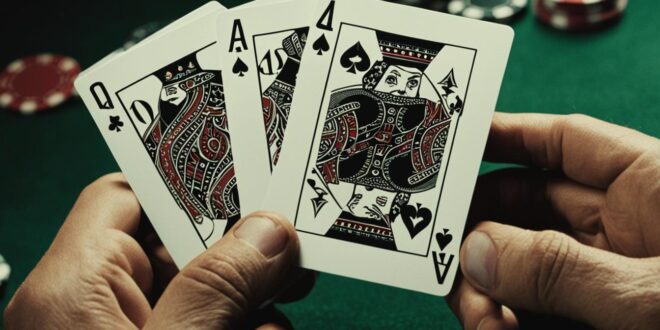What is blackjack? Blackjack, formerly known as black jack and vingt-un, is a popular casino banking game that has become the most widely played casino banking game in the world. It is a comparing card game where players compete against the dealer to reach a hand value of 21 without going over. The game uses decks of 52 cards and is descended from other casino banking games known as “twenty-one”. Blackjack players do not compete against each other; rather, they compete against the dealer to have a higher hand value without exceeding 21.
Key Takeaways:
- Blackjack is a popular casino banking game played with decks of 52 cards.
- The objective is to reach a hand value of 21 without going over.
- Blackjack players compete against the dealer, not each other.
- The game originated from casino banking games known as “twenty-one”.
- Understanding the basics of blackjack is essential to play and enjoy the game.
History of Blackjack
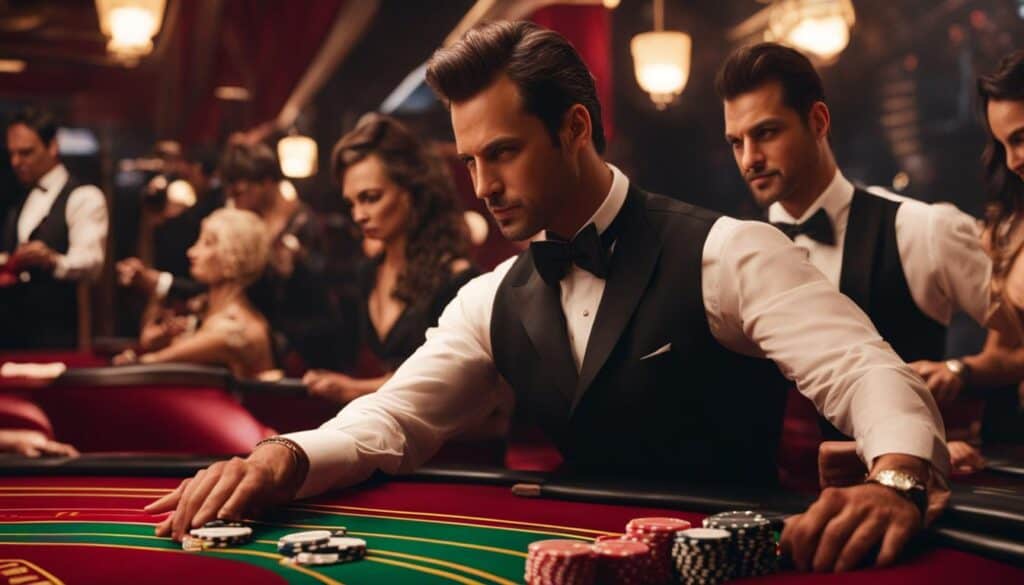
The history of blackjack can be traced back to the 17th century when a similar game called vingt-un was played in French casinos. This precursor to blackjack is believed to have originated in Spain and gained popularity thanks to the famous Spanish author Miguel de Cervantes, who mentioned the game in his book “Rinconete y Cortadillo”.
Vingt-un made its way across Europe and eventually reached the United States in the 19th century. As the game spread, it underwent further modifications and was eventually given the name blackjack. Today, blackjack stands as one of the most recognizable and beloved casino games, firmly ingrained in American casino culture.
Throughout the years, blackjack has evolved and adapted to different cultures and variations, but its roots and influence can be traced back to its Spanish and French origins.
Rules of Blackjack
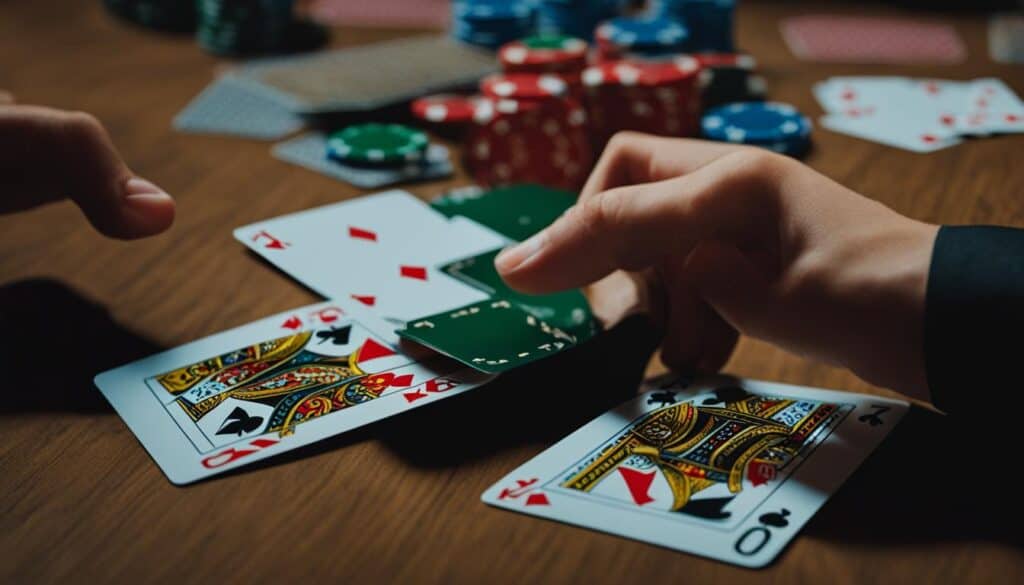
In blackjack, understanding the rules is essential to play the game effectively. The objective of blackjack is to have a hand value higher than the dealer’s without exceeding 21. Here are the basic rules of playing blackjack:
- Card Values: Number cards have a value equal to their face value, while face cards (i.e., jack, queen, king) are valued at 10. The Ace can be counted as either 1 or 11, depending on the player’s choice.
- Placing Bets: The game begins with players placing their bets.
- Dealing Cards: Each player then receives two cards from the dealer.
- Player Options: After receiving the initial cards, players have several options:
- Hit: Take another card to increase the hand value.
- Stand: End their turn without taking another card.
- Double Down: Double their bet and take one more card.
- Split: If the two initial cards have the same value, split them into two separate hands.
- Surrender: Forfeit half the bet and end the hand immediately.
- Dealer’s Turn: After all players have made their decisions, the dealer reveals their cards and follows specific rules for drawing additional cards.
- Winning and Settling Bets: The hand with a total value closer to 21 wins. Bets are settled accordingly.
It’s important to note that these are the basic rules of blackjack, and variations may exist depending on the specific casino or blackjack game being played. Understanding the rules and options available to players is crucial for a successful blackjack experience.
Blackjack Card Values
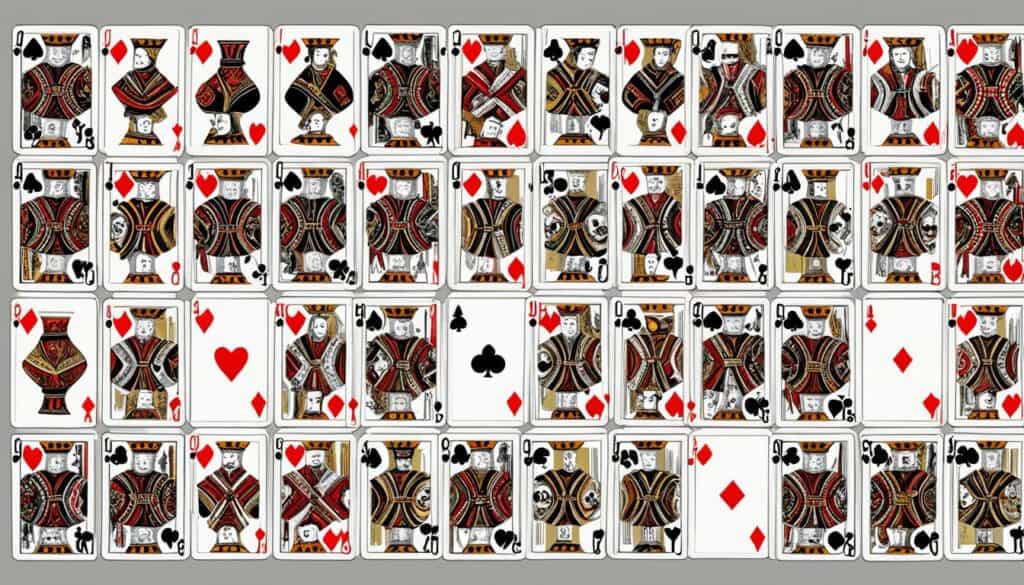
In blackjack, understanding the values assigned to each card is essential to playing the game strategically. Each card holds a specific value, and knowing these values helps players make informed decisions during gameplay.
Number cards (2-10) have a value equal to their respective number. For instance, a 5 of hearts is worth 5 points. Face cards (jack, queen, king) all have a value of 10. For example, a king of spades is also worth 10 points.
The Ace card is a unique and versatile card in blackjack. It can be counted as either 1 or 11, depending on the player’s preference and the overall hand value. For instance, if a player has an Ace and a 6, they can choose to count the Ace as 11, resulting in a hand value of 17 (Ace + 6 = soft 17). Alternatively, the player can count the Ace as 1, resulting in a hand value of 7 (Ace + 6).
Understanding the difference between “hard” and “soft” hands is crucial in blackjack. A “hard” hand does not contain an Ace or contains an Ace counted as 1. A “soft” hand contains an Ace counted as 11. This distinction affects the player’s decisions during the game.
Knowing the card values in blackjack allows players to strategize their moves and make calculated decisions to maximize their chances of winning. By taking into account the values of each card and the overall hand value, players can effectively navigate their way towards a successful outcome.
Blackjack Variations
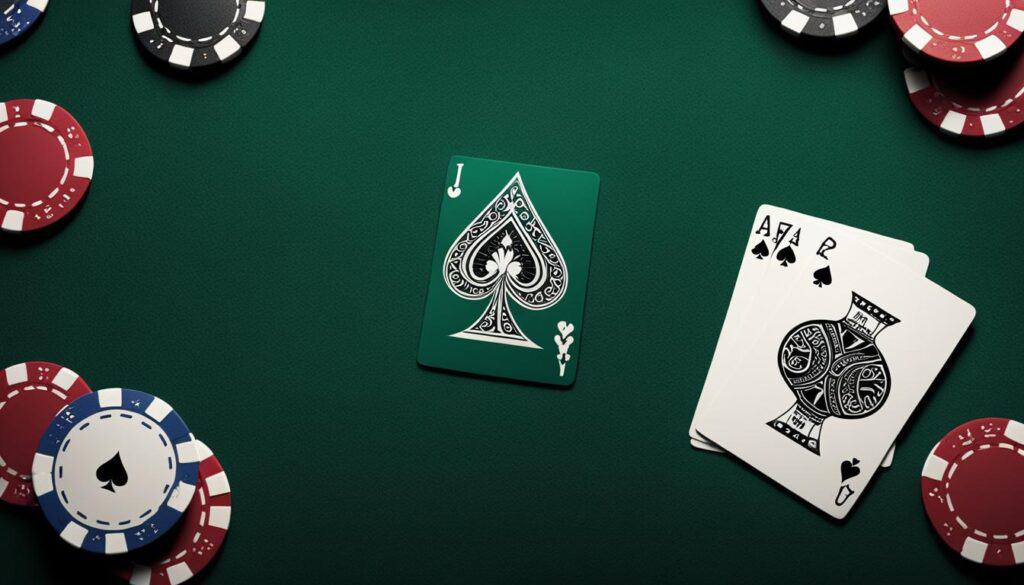
Blackjack has become a beloved card game worldwide, and over the years, it has given rise to various exciting variations. Each variation offers unique rules and features that add a new level of excitement to the game. Familiarizing yourself with these different types of blackjack games can enhance your overall playing experience.
Pontoon
In Pontoon, players aim to get a hand value as close to 21 as possible without going over. The dealer’s cards are face down, adding an extra element of suspense to the game. Players can also choose to twist, stick, or buy cards, making the gameplay strategy-rich and engaging.
Twenty-One
Twenty-One, also known as Spanish 21, is a variation that removes all the 10 cards from the deck, creating a unique twist. Despite the absence of 10s, players have the advantage of various bonus payouts for specific hands, such as a five-card hand totaling 21 or a six-card hand totaling 20.
Siebzehn und Vier
Siebzehn und Vier, translated as Seventeen and Four, is a German variation of blackjack. The goal is to reach a hand value of 17 or 4, and players have the option to draw additional cards or stand. This variation adds a strategic element of determining the optimal time to stop.
Exploring different blackjack variations allows players to experience the game in new and exciting ways. Each variation brings its own set of rules and challenges, making every hand a unique experience.
Basic Blackjack Strategy
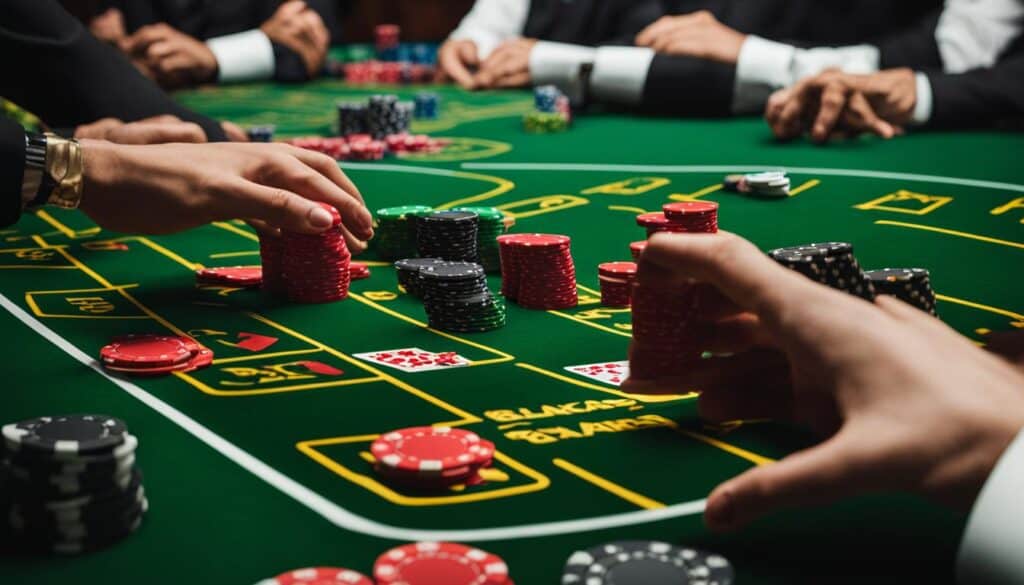
Blackjack is not purely a game of luck; mastering basic strategy can significantly improve your chances of winning. Basic blackjack strategy involves making strategic decisions based on the value of your hand and the dealer’s upcard. By understanding the mathematical probabilities, players can make informed choices that maximize their potential for success and minimize their losses. Utilizing a basic strategy chart can be a valuable tool to help guide your decision-making process.
Basic blackjack strategy is based on the premise that each decision you make should be influenced by the cards in play and the dealer’s hand. It takes into account factors such as the number of decks used, the specific rules of the game, and the likelihood of certain outcomes. By following a predefined set of rules, you can optimize your play and increase your chances of winning.
“The foundation of basic blackjack strategy is understanding the odds and probabilities behind each decision.”
One of the fundamental aspects of basic strategy is knowing when to hit, stand, double down, split, or surrender. These decisions are determined by analyzing your hand value, the dealer’s upcard, and the rules of the game. For example, if you have a hard hand (no Aces) with a value of 12 to 16, it is generally advisable to hit if the dealer’s upcard is 7 or above. On the other hand, if your hand value is 17 or higher, it is usually best to stand regardless of the dealer’s upcard.
Basic strategy also takes into account soft hands (hands containing an Ace) and pairs. For soft hands, the strategy may involve doubling down or hitting depending on the specific combination of cards. When it comes to pairs, basic strategy guides players on whether to split or continue with their original hand.
- When to Hit: If your hand value is low and the dealer’s upcard is strong, it is typically recommended to hit for an additional card.
- When to Stand: If your hand value is relatively high, it is often best to stand and let the dealer take their turn.
- When to Double Down: Doubling down allows you to double your initial bet in exchange for receiving one more card. This move is advantageous when you have a strong hand value and the dealer’s upcard is weak.
- When to Split: Splitting is an option when you have a pair of the same value. It allows you to create two separate hands and place an additional bet. Splitting is often beneficial when you have pairs of 8s and Aces.
- When to Surrender: Surrendering is available in some games and allows you to forfeit your hand and recover half of your bet. This option is typically used when the odds of winning are very low.
Keep in mind that basic strategy is not a guaranteed way to win every hand, but it helps to minimize losses in the long run. While it may seem counterintuitive at times, remember that basic strategy is based on mathematical probabilities and statistical analysis. By following the strategy consistently, you can increase your odds of success over time.
Practice Makes Perfect
Becoming proficient in basic blackjack strategy requires practice and experience. Take the time to study and understand the strategy charts available, and apply them during your gameplay. Start with low-stakes games to gain confidence and refine your decision-making skills. Over time, you will become more comfortable making strategic choices instinctively.
Remember, basic strategy is just one component of a successful blackjack game. Factors such as bankroll management, table selection, and discipline are also crucial to long-term success. By combining these elements with a solid grasp of basic strategy, you can enhance your enjoyment of the game and increase your chances of winning.
Insurance and Doubling Down in Blackjack
In blackjack, players have the option to take insurance or double down under certain conditions. Understanding these strategies can help players make informed decisions and potentially improve their chances of winning.
Insurance in Blackjack
Insurance is a side bet that players can make when the dealer’s upcard is an Ace. It is a wager that the dealer has a natural blackjack, meaning their other card is a 10-value card (10, Jack, Queen, or King). The insurance bet is typically half of the original bet.
If the dealer does have a blackjack, the insurance bet pays out at 2:1 odds, meaning the player will win double the amount of their insurance bet. This provides some consolation for potentially losing the original bet.
However, it’s important to note that taking insurance is generally considered a risky move and is not recommended as a long-term strategy. The odds of the dealer having a blackjack are relatively low, and the insurance bet has a higher house edge compared to other blackjack bets.
Doubling Down in Blackjack
Doubling down is a strategic move that players can make after they receive their first two cards. It allows the player to double their initial bet in exchange for receiving one more card and then standing, meaning they will not receive any more cards after that.
Doubling down is typically advantageous when the player’s hand value is 9, 10, or 11. These are strong starting hands that have a higher chance of improving with just one additional card.
By doubling down, players increase their potential winnings by betting more when they have a good chance of winning. However, it’s important to assess the situation carefully before doubling down, as it can also lead to doubling the potential loss.
It’s worth noting that the rules for doubling down may vary depending on the specific blackjack variant and the casino you are playing in. Some casinos may have restrictions on doubling down, such as allowing it only on certain hand values or limiting the number of times it can be done during a game.
Overall, both insurance and doubling down are additional betting options in blackjack that can add excitement and strategic depth to the game. However, it’s important for players to understand their implications and use them wisely to optimize their chances of success.
Blackjack Dealer Rules

When playing blackjack, it’s essential to understand the rules that govern the dealer’s actions. Blackjack dealers follow specific guidelines set by the casino to ensure fair gameplay. In this section, we will explore the rules that dictate how the dealer plays their hand.
1. Reaching or Exceeding 17: In most blackjack games, the dealer must draw additional cards until their hand value reaches or exceeds 17. This means that if the dealer’s hand value is less than 17, they are required to take another card.
Example: If the dealer’s initial hand consists of a 10 and a 6, totaling 16, they are obligated to draw another card.
2. Soft 17: A soft 17 refers to a hand that includes an Ace counted as 11. Some games have specific rules for how the dealer should handle a soft 17. In certain casinos, the dealer is required to stand when they have a soft 17, while in others, they must draw another card.
Example: If the dealer’s hand consists of an Ace and a 6, totaling 17, which is a soft 17, they may be required to draw another card.
It’s important to note that dealers do not have the flexibility to make decisions based on their hand or the players’ hands. They must strictly adhere to the rules set by the casino. This ensures consistency and fairness in the game.
Understanding the rules that blackjack dealers follow can help players make informed decisions during gameplay. By knowing when the dealer is required to draw additional cards, players can strategize their own moves to increase their chances of winning.
Playing Blackjack at Casinos
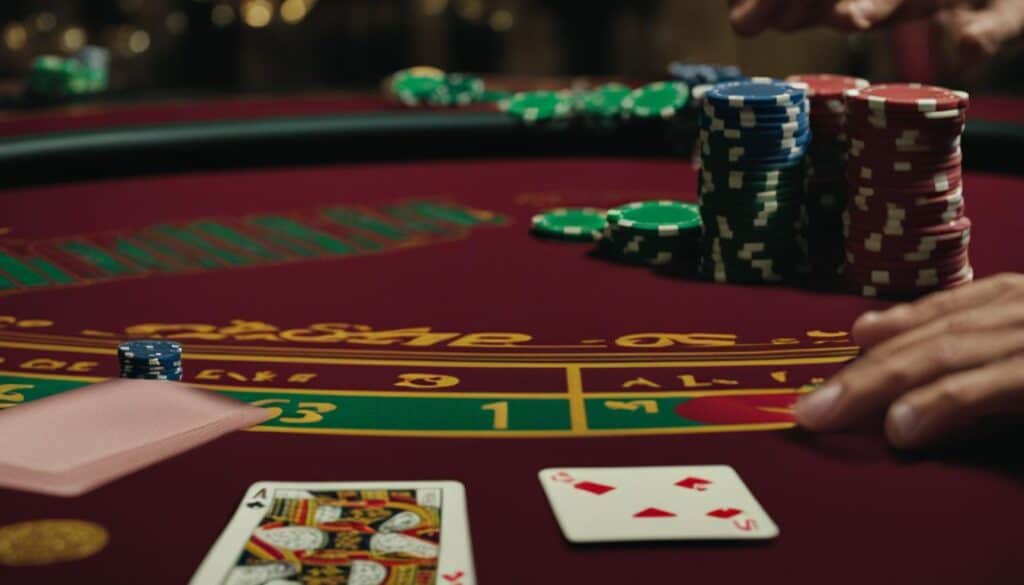
Playing blackjack at casinos is an exciting experience that offers the thrill of making strategic decisions and the possibility of winning big. Whether you’re playing at a physical casino or online, understanding the rules and procedures is essential to maximize your chances of success.
Understanding the Rules
Each casino may have slight variations in the rules of blackjack, so it’s important to familiarize yourself with the specific rules of the casino you’re playing at. This includes knowing the minimum and maximum bet limits, the number of decks used, and any additional rules or side bets that might be offered.
Placing Bets and Receiving Cards
Once you’re ready to play, you’ll need to place your bet within the designated betting area on the table. The dealer will then distribute the cards to each player, typically starting with the player on their left. You’ll receive two cards facing up, while the dealer will have one card facing up and one card facing down.
Making Decisions
After receiving your initial cards, you have several options to choose from depending on the value of your hand and the dealer’s upcard. The most common decisions include:
- Hit: To take another card with the goal of getting closer to 21.
- Stand: To end your turn without taking any more cards.
- Double down: To double your initial bet and receive one additional card.
- Split: If your initial cards have the same value, you can split them into two separate hands. This requires an additional bet equal to your initial bet.
- Surrender: In some casinos, you may have the option to surrender and forfeit half of your bet if you believe your chances of winning are low.
Dealer’s Turn and Settling Bets
After all players have made their decisions, the dealer will reveal their face-down card and follow specific rules for drawing additional cards. The most common rule is for the dealer to hit until their hand value reaches 17 or higher. Once the dealer’s turn is complete, winning bets are paid out and losing bets are collected.
Etiquette and Procedures
When playing blackjack at a physical casino, it’s important to adhere to proper etiquette. This includes not touching the cards, using hand signals to communicate your decisions, and refraining from distracting the dealer or other players. Additionally, be aware of the procedures specific to each casino, such as when to place bets, how to request additional cards, and when to settle bets.
Online casinos also offer the opportunity to play blackjack from the comfort of your own home. These platforms provide a user-friendly interface where you can place bets, receive cards, and make decisions just like at a physical casino. It’s advisable to choose reputable online casinos that use secure and fair gaming systems to ensure a positive experience.
By understanding the rules, making strategic decisions, and practicing good etiquette, you can enhance your enjoyment of playing blackjack at casinos and increase your chances of success.
Tips for Playing Blackjack

Improving your blackjack game requires a combination of strategic thinking and sound decision-making. By following these tips and strategies, you can enhance your chances of success and enjoy the thrilling experience of playing blackjack.
- Learn and Implement Basic Strategy: Familiarize yourself with the basic strategy chart and make decisions based on optimal play. This will help you maximize your chances of winning and minimize your losses.
- Manage Your Bankroll Effectively: Set a budget for your blackjack session and stick to it. Avoid chasing losses and know when it’s time to take a break. By managing your bankroll wisely, you can play for longer and increase your overall enjoyment.
- Know When to Take Insurance or Double Down: Insurance can be a tempting option, but it’s generally not advisable unless you’re counting cards. As for doubling down, it’s recommended when you have a strong starting hand, such as a total of 9, 10, or 11.
- Be Aware of Table Limits and Rules: Different casinos may have varying table limits and rule variations. Before sitting down to play, familiarize yourself with the specific rules of the table to ensure you make the most informed decisions.
Remember, practice makes perfect. The more you play blackjack, the more you’ll understand the intricacies of the game and develop your own strategies. So, take your time, enjoy the process, and hone your blackjack skills to become a skilled and successful player.
Famous Blackjack Players

Throughout history, there have been several famous blackjack players who have made significant contributions to the game. Some notable players include:
- Edward O. Thorp: Edward O. Thorp is a mathematician, author, and blackjack player famous for his book “Beat the Dealer.” In his book, Thorp introduced card counting techniques and mathematical strategies that revolutionized the way blackjack was played. His work paved the way for professional blackjack players to gain an edge over the casino.
- The MIT Blackjack Team: The MIT Blackjack Team was a group of students and graduates from the Massachusetts Institute of Technology who used their mathematical skills to beat the casinos. They employed card counting techniques and strategic betting to win millions of dollars in various casinos around the world. Their story was immortalized in the book “Bringing Down the House” and the movie “21.”
These famous blackjack players have not only achieved success in the game but have also contributed to its evolution. Their skills, strategies, and dedication to mastering blackjack have made them notable figures in the world of professional blackjack players.
Blackjack Myths Debunked
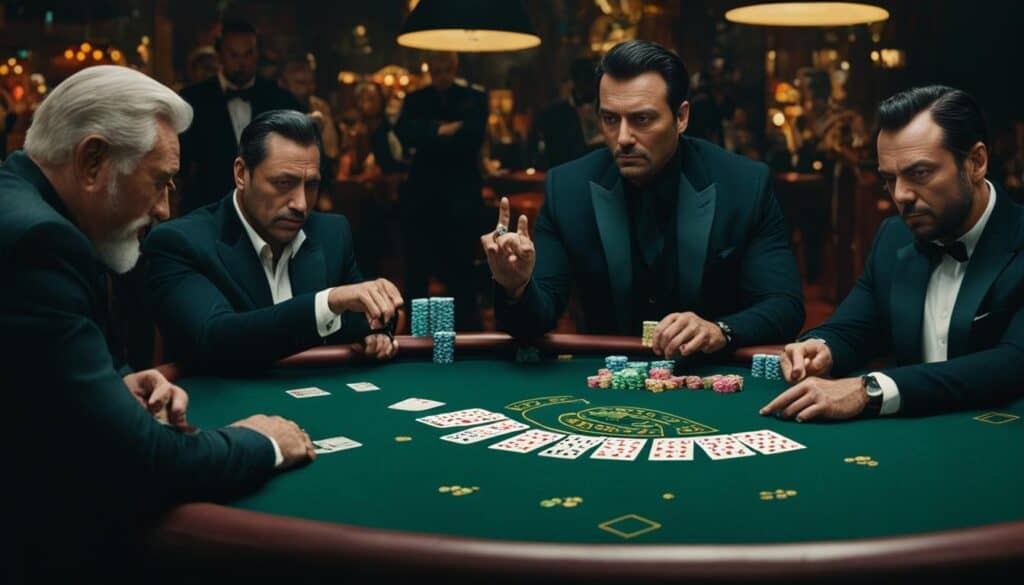
There are several common blackjack misconceptions that have led to the emergence of myths surrounding the game. By debunking these myths, players can gain a clearer understanding of the reality of playing blackjack and make more informed decisions.
One of the most prevalent myths is that counting cards is illegal. While casinos may discourage and even ban card counting, it is not illegal in and of itself. As long as players rely on their own mental calculations and do not use any external aids, card counting is a legitimate strategy that can be employed.
Another commonly held myth is that the dealer always has a 10 or an Ace in the hole. This misconception stems from the prominence of these cards in blackjack and the fear that the dealer will always have a strong hand. However, the probability of the dealer having a specific card is influenced by the number of decks in play, making it far from certain that the dealer’s hole card is a 10 or an Ace. It is important for players to remember that the dealer’s hand is subject to the same principles of probability as the players’ hands.
Separating fact from fiction is crucial when it comes to playing blackjack. By dispelling these myths, players can approach the game with a clearer perspective and make decisions based on accurate information.
Online Blackjack
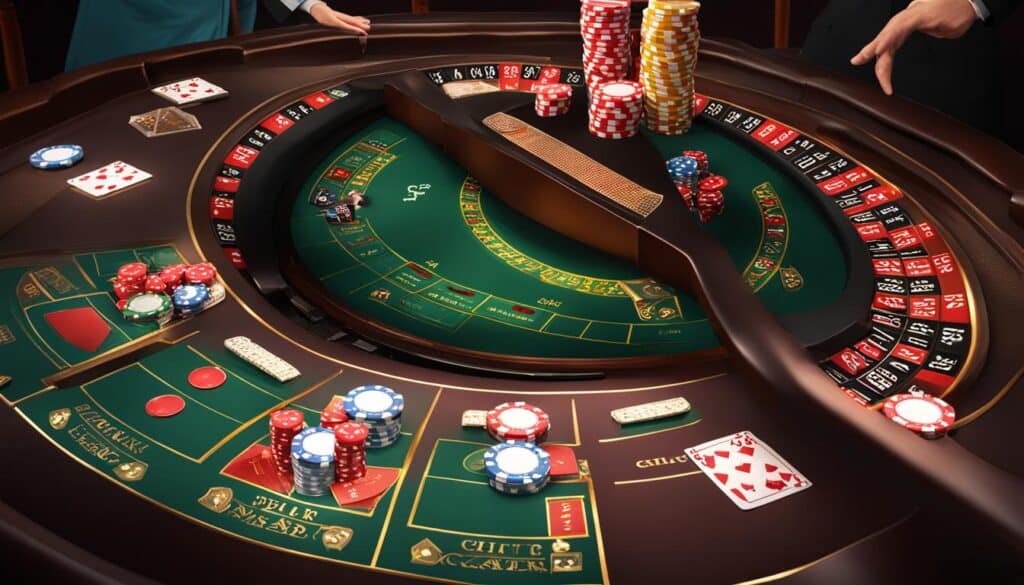
Online casinos offer the opportunity to play blackjack from the comfort of your own home. With just a few clicks, players can access a wide variety of blackjack games and variations online. Whether you’re a beginner or a seasoned pro, online blackjack provides an immersive and convenient gaming experience.
The rules and gameplay of online blackjack are similar to those at physical casinos. The goal is to beat the dealer’s hand without exceeding a total of 21. Players are dealt two cards and can then choose to hit (draw another card), stand (end their turn), double down (double their bet and draw one more card), or split (if the initial two cards have the same value, split them into two separate hands).
One of the advantages of playing blackjack online is the ability to access a wide range of table limits and betting options. From low-stakes tables suitable for beginners to high-roller tables for more experienced players, there’s something for everyone. Additionally, online casinos often offer various blackjack variations, such as Spanish 21, European Blackjack, or Multi-Hand Blackjack, allowing players to explore different gameplay and strategies.
Choosing a Reputable Online Casino
When playing blackjack online, it’s crucial to choose a reputable online casino. Look for licensed and regulated platforms that guarantee fair play and secure transactions. Reading reviews and checking for certifications can help you ensure that you’re playing in a safe and reliable environment. Additionally, consider the casino’s reputation, customer support, and available payment options before making your decision.
Playing blackjack online can be an exciting and rewarding experience. The convenience of being able to play anytime, anywhere, coupled with the wide range of game options, makes it a popular choice among players. So, if you’re ready to try your luck and test your blackjack skills, give online blackjack a spin!
Blackjack in Pop Culture
Blackjack has become ingrained in popular culture through its portrayal in various mediums, including movies and music. The game’s thrilling and high-stakes nature adds excitement and suspense to storylines, captivating audiences worldwide.
Movies
Blackjack scenes have left a lasting impact on the silver screen, with iconic moments showcased in films such as “Rain Man” and “21”. In “Rain Man”, the character Raymond Babbitt, portrayed by Dustin Hoffman, demonstrates extraordinary blackjack skills as a savant, leaving viewers in awe of his mathematical abilities. “21” tells the captivating tale of a group of MIT students who use strategic card counting techniques to beat the casinos at blackjack.
“In the popular movie ‘Rain Man’, the scene where Raymond Babbitt accurately counts cards and wins big at the blackjack table showcases the allure and excitement of the game.”
Music
Blackjack references can also be found in various songs, demonstrating the game’s influence on music artists. Kenny Rogers immortalized blackjack in his legendary song “The Gambler,” while Ray Charles paid homage to the game with his soulful rendition of “Blackjack”. These musical tributes further solidify blackjack’s place in pop culture.
- Kenny Rogers – “The Gambler”
- Ray Charles – “Blackjack”
The fusion of blackjack with movies and music has elevated its status in pop culture, making it a compelling and captivating element in entertainment.
Conclusion
Blackjack, a timeless and popular card game, has captivated players for centuries. Its simple rules and strategic gameplay make it an engaging and rewarding experience. Whether playing at a physical casino or online platform, blackjack offers thrilling moments and the potential for big wins.
From its origins in French casinos to its prominence in modern gambling, blackjack has solidified itself as a classic casino game. It has become a staple at casinos around the world, attracting both seasoned players and newcomers looking for excitement and entertainment.
To maximize their chances of success, players should familiarize themselves with the rules of blackjack and implement basic strategies. By understanding the value of each card, when to hit or stand, and when to double down, players can make informed decisions and improve their odds. Practice is also crucial, as experience and skill can greatly influence a player’s performance at the blackjack table.
Whether you’re a beginner or a seasoned player, the world of blackjack provides endless opportunities for enjoyment and thrill. So dive into the exciting world of the game, try your luck, and see if you can beat the dealer in this classic casino favorite.
FAQ
What is blackjack?
Blackjack is a popular casino banking game where players compete against the dealer to reach a hand value of 21 without going over.
What is the history of blackjack?
Blackjack, formerly known as vingt-un, originated in French casinos in the 17th century and made its way to the United States in the 19th century.
What are the rules of blackjack?
The objective is to have a hand value higher than the dealer’s without going over 21. Players can hit, stand, double down, split, or surrender, and the dealer follows specific rules for drawing cards.
What are the card values in blackjack?
Number cards have their face value, face cards count as 10, and the Ace can be counted as either 1 or 11.
What are some blackjack variations?
Popular variations include Pontoon, Twenty-One, and Siebzehn und Vier, each with their own set of rules and features.
What is basic blackjack strategy?
Basic strategy involves making decisions based on the player’s hand value and the dealer’s upcard to maximize chances of winning or minimizing losses.
What is insurance and doubling down in blackjack?
Insurance is a side bet on the dealer having a blackjack, and doubling down allows players to double their bet and receive one more card.
What are the dealer rules in blackjack?
Dealers must follow specific rules for drawing cards, typically standing on a total of 17 or drawing another card if they have a soft 17.
How do you play blackjack at casinos?
Players place bets, receive two cards, and then make decisions based on the rules of the game. The dealer handles the cards and follows the rules for drawing additional cards.
What are some tips for playing blackjack?
Tips include learning basic strategy, managing bankroll effectively, and knowing when to take insurance or double down.
Who are some famous blackjack players?
Notable players include Edward O. Thorp and the MIT Blackjack Team, who made significant contributions to the game.
What are some common blackjack myths?
Common myths include that counting cards is illegal and that the dealer always has a 10 or an Ace in the hole.
How do you play blackjack online?
Online casinos offer blackjack games where players can play from the comfort of their own homes, following similar rules and gameplay as physical casinos.
How is blackjack portrayed in pop culture?
Blackjack has been featured in movies and referenced in music, adding excitement to storylines and entertainment.
 Online Gaming Circuit
Online Gaming Circuit
